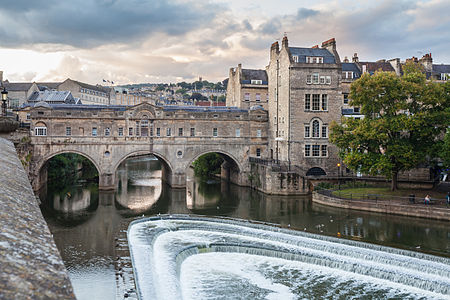Pulteney Bridge

Pulteney Bridge is a bridge over the River Avon in Bath, England. It was completed by 1774, and connected the city with the land of the Pulteney family which it wished to develop. Designed by Robert Adam in a Palladian style, it is highly unusual in that it has shops built across its full span on both sides. It has been designated as a Grade I listed building.Within 20 years of its construction, alterations were made that expanded the shops and changed the façades. By the end of the 18th century, it had been damaged by floods, but was rebuilt to a similar design. Over the next century alterations to the shops included cantilevered extensions on the bridge's north face. In the 20th century, several schemes were carried out to preserve the bridge and partially return it to its original appearance, enhancing its appeal as a tourist attraction. The bridge is now 45 metres (148 ft) long and 18 metres (58 ft) wide. Although there have been plans to pedestrianise the bridge, it is still used by buses and taxis. The much photographed bridge and weir below are close to the centre of the city, a World Heritage Site, renowned for its Georgian architecture.
Excerpt from the Wikipedia article Pulteney Bridge (License: CC BY-SA 3.0, Authors, Images).Pulteney Bridge
Pulteney Bridge, Bath Walcot
Geographical coordinates (GPS) Address External links Nearby Places Show on map
Geographical coordinates (GPS)
| Latitude | Longitude |
|---|---|
| N 51.383055555556 ° | E -2.3577777777778 ° |
Address
Pulteney Bridge
Pulteney Bridge
BA2 4AY Bath, Walcot
England, United Kingdom
Open on Google Maps










